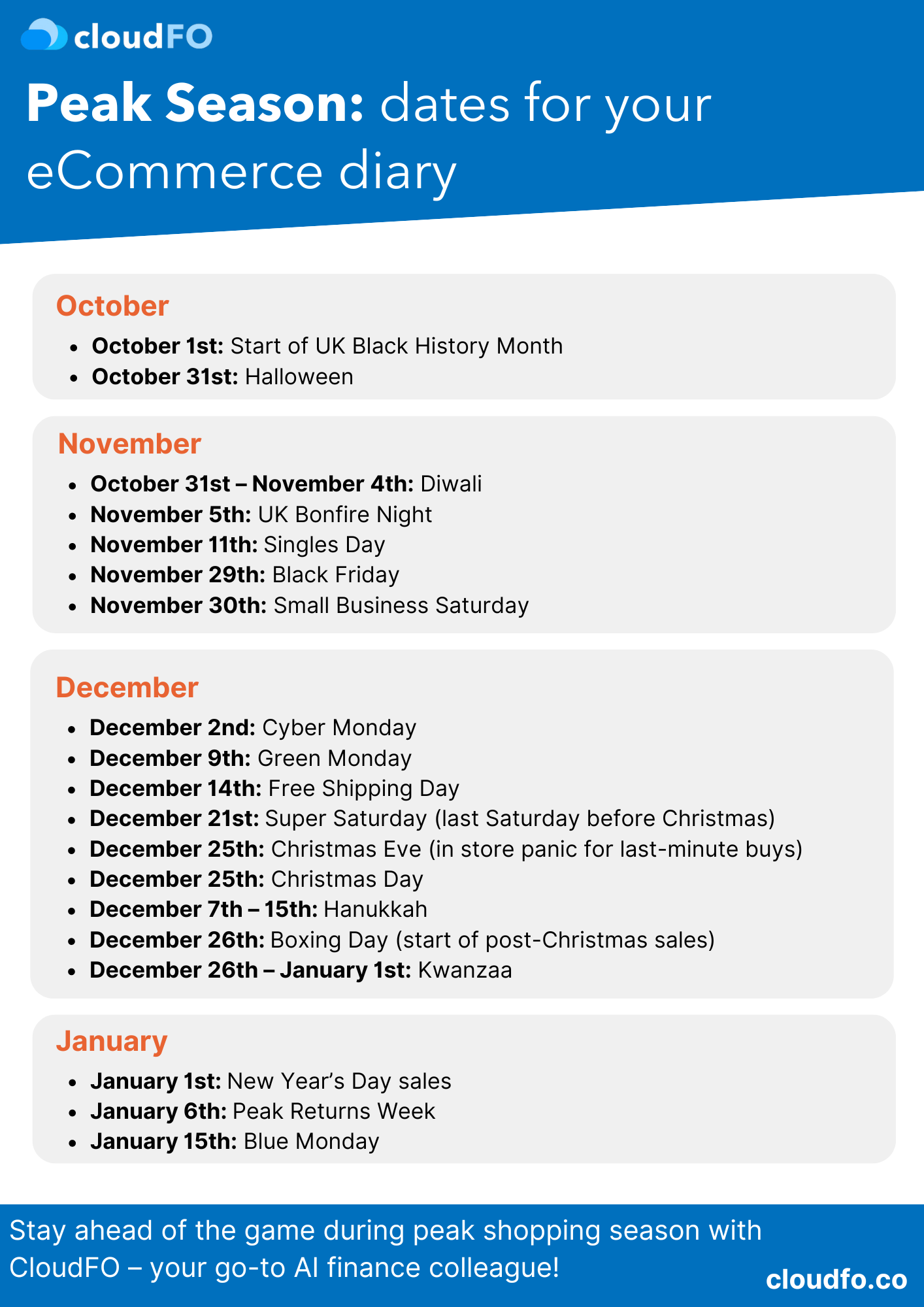Preparing for Peak Season: Black Friday, Cyber Monday, Christmas and Beyond

We have just entered Q4, its official peak season. Many businesses start planning for this period 3-6 months ahead, but don't panic if you haven't started yet. In this article, we'll discuss how you can still get prepared.
As implied by its name, the peak season is the most important and busiest trading time for eCommerce businesses. Traditionally, key dates for the peak season included Black Friday, Cyber Monday, and the Christmas holiday season. However, in recent years, this period has expanded to encompass much more.

Peak Season Statistics
In the UK, shoppers spent a record £1.04 billion online on Black Friday 2023, contributing to a total of £8.74 billion over the weekend, including £3.9 billion in stores.
While Christmas Eve tends to be one of the slowest days for online sales—with in-store retailers seeing a last-minute rush but often having reduced opening hours—don't overlook Christmas Day. Last year, UK shoppers spent £1 billion online on Christmas Day.1
Remember that your business may have specific peak periods outside this timeframe. For example, if you are a swimwear brand, your peak season might be in the spring or summer, while other businesses may experience a surge during back-to-school periods.
Strategy for Peak Season
- Plan Ahead: Early planning allows you to refine your strategy, giving you the time to determine the direction you want to take, how much you are willing to invest, and which key dates to target. This forward-thinking approach also helps you allocate resources effectively and maximise returns on investment.
- Review Past Data and Industry Trends: Leverage data from previous peak seasons to guide your strategy. Tools like CloudFO can help you analyse past campaigns and trading results in seconds. By reviewing sales data, customer behaviour, and campaign performance, you'll gain valuable insights into what worked and what didn't. Additionally, keep an eye on last year's industry and category trends, and try to anticipate what your competitors may have planned for this year.
- Plan Promotions: During this period your customers are actively seeking deals. Plan your promotions for key dates such as Black Friday, Cyber Monday, and Boxing Day through New Year's Day. Decide when your promotions will begin, how long they'll run, and which offers will resonate most with your audience.
Consider implementing:
Example 1 - Flash Sales: Short-term Offers to Drive Urgency:
Offer a % off sale for 24 hours on your hero product—something popular or highly sought-after by customers. This type of promotion could encourage customers who have been considering trying the product to finally take the plunge, driven by the fear of missing out on a limited-time deal.
Example 2 - Multi-day Promotions: To maintain customer engagement over a longer period:
Run a 5-day promotion leading up to Cyber Monday, offering a new deal each day. For a beauty brand, you could feature a different product each day, such as: Day 1: 30% off serums, Day 2: 25% off cleansers and Day 3: 20% off moisturisers.

This keeps customers coming back daily to see the new offers, building anticipation and repeat engagement
Example 3 - Staggered Offers: To sustain interest throughout the season:
For a service business targeting other businesses during peak season, staggered offers can be effective. For example, a B2B logistics provider could offer:
- November: 10% off warehouse storage solutions
- Early December: Discounted rates on expedited shipping services
- Last two weeks of December: Free consultation for clients looking to streamline their post-holiday returns process
This approach enables service businesses to support their clients at key stages throughout the peak season, maintaining continuous engagement while delivering solutions when they're needed most. These offers provide clients with valuable resources or services that enhance their performance during busy periods, fostering long-term loyalty through personalised support.
- Get Rid of Old Stock: Promotions can be a strategic tool for clearing out slow-moving stock while encouraging higher spending. By offering discounts on bundled products, you can increase your average order value during peak season. For example, consider creating gift bundles or discounted sets that pair less popular items with best-sellers.
- Theme Propositions Around Key Dates: Peak season isn’t just about discounts, customers are also looking for gifts and occasion-specific products. You can create special editions of your products or bundle gift sets to meet seasonal demand, such as Halloween-themed items or Christmas gift packs. For these types of offerings, price reductions may not be necessary, and you could even charge a premium based on their exclusivity or relevance to the season.
- Plan Marketing, Creative Content, and Ad Campaigns: Your promotional strategy should be complemented by a well-planned marketing approach. Develop a detailed schedule for creating marketing content, from email campaigns to social media ads, and set a clear budget for each channel. Tailor your content to align with your seasonal offers and target audience, making sure it aligns with your overall strategy. In particular, time your paid advertising to coincide with your promotional launches to maximise visibility and impact.
- Forecast Demand and Budget for Resources: Utilise the insights gained from analysing past data and planning your promotions to forecast demand and budget for the necessary resources, including stock, labour and logistics. Be prepared to manage the volume of orders and customer inquiries that will arise during the peak season. Ensure your fulfilment and customer service processes are equipped to meet delivery deadlines, and consider increasing your workforce to accommodate the anticipated rise in demand, keeping this in mind as part of your budget.
- Profitability Assessment: As you forecast demand and budget for resources, ensure that your strategy remains profitable. If additional costs—like staffing, logistics, or heavy discounts—reduce your margins, assess whether you can justify the loss. Sometimes, a short-term dip in profitability can be strategic, helping you clear old stock, gain new customers, or increase brand awareness. However, it’s essential to weigh these benefits against the financial impact to ensure any losses serve a clear, long-term business goal. Don’t worry - CloudFO is here to assist you with this.
- Automations: Leveraging automation tools can significantly enhance efficiency during the peak season. Implement automated email marketing campaigns for cart abandonment reminders, targeted promotions, and follow-ups, ensuring you re-engage customers who didn’t complete their purchases. Additionally, set up retargeting ads to remind potential customers of items they viewed or added to their carts, encouraging them to return.
Additionally, consider incorporating gamification elements, such as loyalty points for purchases or referral bonuses, to enhance engagement and encourage repeat business. Automate workflows for abandoned cart recovery by sending reminder emails with incentives like discounts or free shipping, motivating customers to finalise their purchases. By automating these processes, you can efficiently manage increased customer interactions and boost conversion rates during the busy peak season.
Operational Planning for Peak Season
- Stock and Inventory Management: Begin by 'taking stock' and thoroughly analysing your current inventory to ensure you have enough to meet the heightened demand. Factor in both your regular demand and the anticipated increase during the peak season. Running out of popular products can lead to missed sales opportunities, so use your demand forecast to order accurately. If you rely on manufacturers, confirm their lead times remain consistent, as they may also be facing peak season pressures. You might want to consider alternative inventory management strategies, such as just-in-time or just-in-case stock, to better handle this period. For more information, read our article on inventory management.
- Resource Planning and Staffing: In addition to managing product inventory, use your demand forecast to assess the need for additional resources, particularly staffing. Many businesses recruit 'seasonal staff''—temporary workers hired to manage the increased workload caused by higher demand. Now is the ideal time to start recruiting to ensure you have enough personnel in place. Seasonal staff can fill various roles, from warehouse support to customer service, helping to keep operations running smoothly during the busiest times.
- Test and Scale Your Website: While your website may already provide an excellent user experience, peak seasons often lead to surges in traffic that can strain even the most robust systems. Major companies have experienced outages during these busy periods due to this pressure. Although platforms like Shopify typically manage traffic scaling effectively, it's essential to test for any potential issues. Ensure a smooth and painless checkout experience by checking for broken links, making certain that product and service descriptions are clear, and providing easy access for customers to contact support. Have FAQs readily available, and ensure your website performs well on both mobile and desktop devices, across all browsers, and for users with varying accessibility needs. Optimising loading speeds and delivering a seamless user experience will be crucial for boosting conversions. Shopify provides a guide on preparing your website here. Additionally, enhancing customer interaction with features like wish lists can further optimise their shopping experience and aid in planning.
- Content Creation: Standing out in a saturated market during peak season can be challenging. Consider how your brand can differentiate itself. For instance, last year, some companies adopted a 'Green Friday' approach, promoting sustainability over consumerism. You could create content that aligns with your brand’s values, such as gift guides or recipe cards that demonstrate how to use your products or services. If your strategy includes new content creation—such as photo or video shoots—now is the time to book any models, photographers, or other necessary professionals. Ensure you factor in lead times for editing and post-production so that everything is ready for release well in advance of the peak period.
- Communicate Key Dates and Cut-offs: It’s crucial to plan and clearly communicate key dates to both your team and customers. Decide on specific cut-off dates, such as the final day for customers to place orders for delivery before Christmas or New Year’s. These dates should be prominently displayed on your website, in marketing materials, and through customer communication channels such as email or social media. Setting clear expectations helps manage customer satisfaction and reduces any confusion or disappointment regarding delivery delays. This planning also enables your logistics team to prepare for a smooth fulfilment process during the busiest days of the year.
Reduce the Stress
It’s called peak for a reason, so it’s essential to minimise stress for both your team and customers. Here are some strategies to consider:
- Delivery Windows: Adjust or extend delivery windows and communicate these changes clearly, ideally before the point of purchase, but at a minimum, at that point. This ensures customers have realistic expectations about when their orders will arrive.
- Return Periods: Consider extending return periods to provide customers with added flexibility. You may also want to offer free returns during this period, as 47% of shoppers say free returns would influence their choice of retailer. This can alleviate concerns about buying gifts during the busy season.2
- Sale Periods: Extend the sale period or start promotions early to smooth out demand. This approach can help prevent overwhelming your staff and logistics while ensuring that customers have ample time to shop without the pressure of last-minute purchases.
Next week, we’ll discuss effective strategies for managing your operations once peak season is in full swing.
https://www.statista.com/topics/871/online-shopping/


Download and save the key dates to your calendar below!





